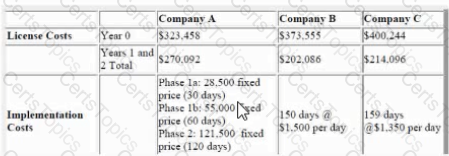A business analyst (BA) on a project is in the process of validating requirements and finds that there is a high degree of uncertainty related 10 one of the assumptions being true. The BA adds the assumption to the risk register and performs a fun risk analysis to handle this situation. What type of strategy is in place if the organization is risk-averse?
A business analyst (BA) is assigned to a project which has two main stakeholders: a highly regulated government agency and a less formal private company. To select the business analysis approach, the BA mi! conduct a meeting with representatives from each entity to decide on the level of formally needed for requirements and design specifications. During the meeting, what should the BA’s strategy be?
An insurance company wants to implement a business intelligence solution to consolidate data from various different internal system to provide a better understanding of their customer base.
A business analysis (BA) is engaged to put together a tender (bid) to be sent to various business intelligence providers and implementation partners. Among other information the business analysis requests the following:
* Licensing costs for year 0 based on needing 1 Central processing Unit (CPU) license
* Licensing costs for specific user types such as Report Creators Online Analytical Process (OLAO) user and Power users
* Predicted licensing costs for renewing in Years 1 and 2
* Full implementation costs
After reviewing the received vendor responses the project team shortlists the candidates to 3 and the BA structures the received information as follows:

The Insurance company has a maximum bucket of $310,000 for the entire to implementation and operation over the first three years. Which vendor or vendors meet that criterion?

What kind of analysis must the BA do to determine if one of the systems is better suited to be modified and upgraded?